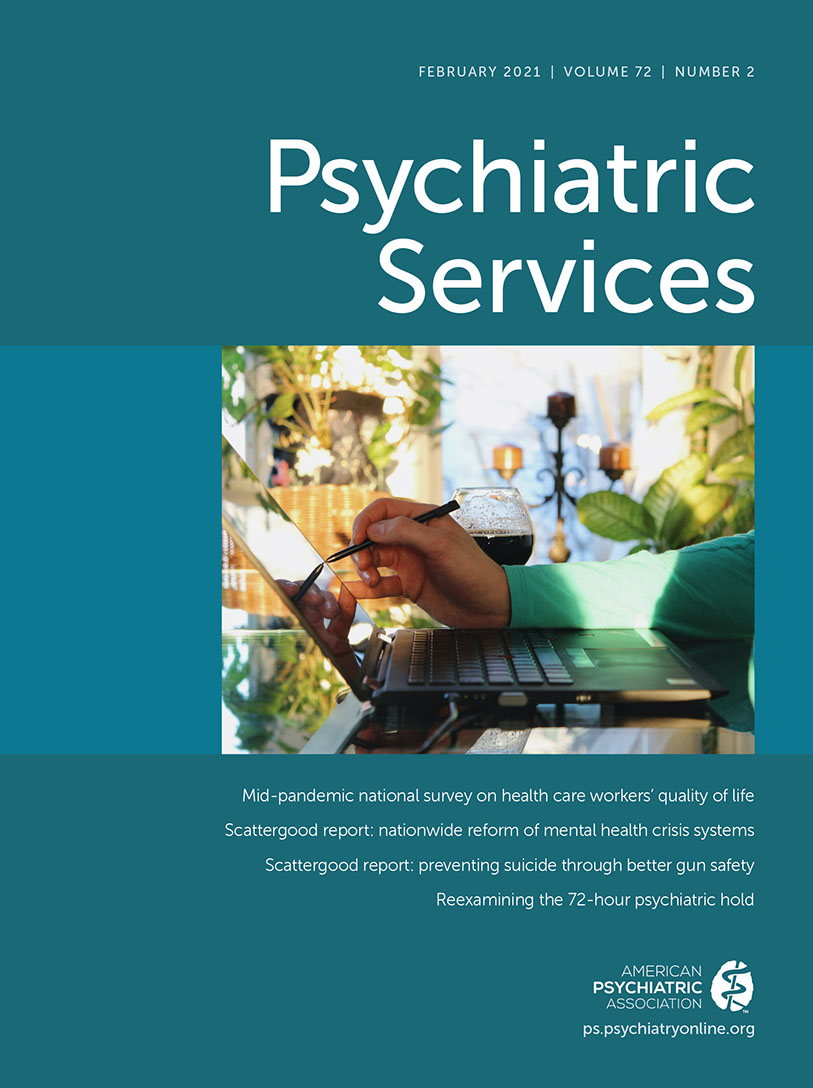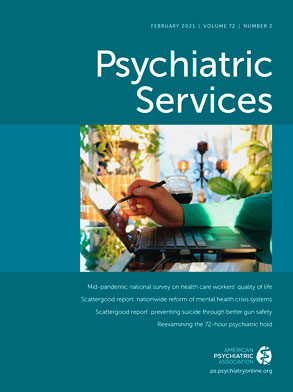The suicide death rate in the United States has increased by 35% over the past two decades (
1), despite federal investment in research to “understand the neurobiological underpinnings of suicide and [develop] suicide risk screening tools for use in medical settings” (
2). During the same period, medical and public health advances have brought steep declines in mortality from heart disease (down 39%), cancer (down 23%), and stroke (down 38%) (
3,
4). What makes suicide different as a public health problem, and what should be done differently to address it?
Thinking Differently About Suicide as a Socially Determined Public Health Problem
The traditional approach to suicide prevention has tended to view suicidal behavior as symptomatic of an insufficiently treated mental health condition. In support of this model, epidemiological research has found that people with serious psychiatric illnesses and substance use disorders have an eightfold increased relative risk of suicide (
5,
6) and that suicide rates are lower in populations with greater access to mental health care (
7). Such studies imply that suicide prevention should focus on finding at-risk individuals with behavioral health disorders and improving their access to effective treatment, including timely hospitalization when needed. Examples of this approach include suicide screening and risk assessment protocols in clinical settings, public education on how to recognize suicide warning signs and “get help,” and the proliferation of crisis line telephone services (
8).
The mental health–focused model is not necessarily wrong, as far as it goes, but it comes up short in preventing a large number of suicides. Available mental health treatment is not always effective in ameliorating suicidal symptoms (
9). About one in five suicide decedents were currently being treated for a mental health problem when they died (
10), and recently discharged psychiatric hospital patients have a suicide rate 100 times higher than the rate in the general population (
11). Also, many important risk factors for suicide are unrelated to having a mental illness or an addiction disorder and fall outside the scope of standard behavioral health care interventions. On average across studies, the proportion of suicide risk that is attributable to behavioral health disorders is approximately 57% in the male population and 77% among females; the rest is attributable to social, economic, circumstantial and other factors with little or no connection to psychopathology (
12). Access to lethal means is perhaps the most important circumstantial driver of suicide mortality in the United States and is amenable to policy interventions that have untapped potential to prevent a large number of suicide deaths (
13).
An estimated 1.4 million people in the United States survived a suicide attempt in 2017 (
14), and about 47,000 died (
1). Clearly, the overwhelming majority of people who try to end their own life get a second chance. However, case-fatality rates vary dramatically by the method of intentional self-harm. People who use a firearm to attempt suicide seldom survive; nearly nine out of 10 die (
15). Guns account for over half of suicide deaths, and suicides account for about 60% of firearm-related fatalities (
1). In the United States, men are nearly four times more likely than women to die of suicide, even though men have lower rates of depression (
16). Greater access to firearms is one reason for this paradox; 62% of gun owners (
17) and 86% of gun suicide decedents are men (
1).
Gun safety thus deserves a special focus in suicide prevention, especially in the male population. The policy challenge is to develop and broadly implement more effective strategies—including legal tools—to keep guns out of the hands of people at highest risk of suicide, without unduly infringing the Second Amendment rights of a large number of gun owners who are unlikely to harm anyone (
18).
Promise and Challenge of Implementing Gun Policy to Prevent Suicide
Private gun ownership in the United States is highly prevalent (
19), culturally entrenched (
20,
21), corporately sustained (
22), constitutionally protected (
23), and politically divisive (
24,
25). In this social context, and in contrast with other advanced nations, neither federal nor state laws can broadly limit the general public’s access to firearms. Rather, gun restrictions must be narrowly tailored and targeted to categories of people with objective indicators of dangerousness—such as those convicted of a felony or a domestic violence crime or involuntarily committed to a psychiatric hospital (
26). But the majority of suicide decedents do not fall into those legal categories, and most persons who are prohibited access to guns are not at high risk of dying by their own hand (
27). Thus, in terms of suicide prevention, the 1960s-era federal gun-prohibiting criteria premised on lifetime criminal and civil adjudication records (
28) are overbroad and too narrow at the same time (
29,
30).
To be more successful in reducing the suicide rate, firearm laws in the United States must accomplish three intermediate goals: first, modify existing gun prohibitions so they apply to more people at a higher risk of suicide (
31); second, comprehensively enforce these improved restrictions, both by denying illegal gun acquisitions at the point of sale and requiring newly prohibited persons to surrender the guns they may already possess (
32); and third, develop and implement legal tools to remove access to firearms—at least temporarily—from otherwise gun-eligible individuals who manifest a high risk of suicide, including laws giving those with insight into their own potential future risk of self-harm the agency to prohibit themselves from buying guns through a voluntary and reversible waiver of firearm rights (
33). These policy goals must be pursued in such a way as to avoid infringing the rights of many gun owners who pose no danger and without unduly compromising the privacy of psychiatric patients or eroding health care professionals’ therapeutic role (
34).
Since the federal Brady Handgun Violence Prevention Act was enacted in 1993 (
35), the requirement for a background check before an individual buys a firearm from a licensed dealer has been the lynchpin of gun safety policy in the United States. Established to implement the Brady Act, the FBI’s National Instant Criminal Background Check System (NICS) has been in operation since 1998. But a background check is only as good as the legal criteria for denying a sale, the quality and completeness of records in the database, the timeliness of reporting from state authorities, the reach of the requirement to all gun transfers, the suppression of illegal gun markets, and the foreclosure of alternative ways in which prohibited or otherwise dangerous persons can access guns. These moderating conditions have diminished the benefit of background checks to date (
36,
37), but they highlight opportunities to make the system work better.
Psychiatric patients with a record of involuntary civil commitment have been legally disqualified from purchasing or possessing firearms since Congress enacted the Gun Control Act of 1968 (
28). This prohibiting category invites scrutiny through the lens of contemporary suicide prevention goals. During the era when the law was passed, a substantial proportion of adults with serious mental illnesses spent time in state mental hospitals under involuntary commitment orders (
38,
39). A half-century later, after thoroughgoing deinstitutionalization and reform of states’ civil commitment statutes, only about 1% of the 11.4 million adults with serious mental illnesses in the United States experience involuntary commitment in a given year (
40,
41).
Over the past decade, many states have reported their entire archives of historical commitment records to the NICS, dramatically expanding the number of gun-disqualifying mental health records in the database from approximately 650,000 in 2009 to 5.7 million in 2018. Less than 1% of these mental health records have resulted in denial of a firearm sale or license application (
42). Thus, even while a much smaller proportion of people with serious mental illnesses than in the past are becoming legally disqualified from possessing guns because of a contemporaneous civil commitment episode, an increasingly large number have had their names added to the NICS by dint of a record from their remote past (
30,
43). As a result, over time the correlation has decayed between involuntary commitment as a lifetime gun disqualifier and actual risk of suicide among the persons it has disqualified. Three federal appeals courts have recently issued differing opinions in deciding legal challenges to the lifetime gun prohibition conferred by civil commitment as applied to former psychiatric patients with remote commitment records (
44).
Meanwhile, short-term holds for evaluation in a mental health crisis have become far more common than longer-term involuntary commitments, particularly in some states (
41). Florida, with its extensive use of the Baker Act (
45), is an instructive example. In a recent longitudinal study of suicide outcomes among 81,704 adults diagnosed as having schizophrenia, bipolar disorder, or depression in the public behavioral health system in Florida, only 12.8% of patients were found to have records of involuntary commitment; 33.5% had experienced an involuntary psychiatric examination before being released within 72 hours or hospitalized voluntarily. Nearly three out of four gun-suicide decedents in the study could have passed a federal background check to purchase a firearm. However, more than half of these gun-eligible individuals who died by gun suicide had a history of a short-term psychiatric emergency hold for examination (
27). In Florida, and in more than half of the other states, this type of short-term hold for examination, absent a commitment order, does not confer even a temporary restriction from firearms (
46). This presents an opportunity for a life-saving policy reform.
Interventions with persons who have alcohol use disorders present another important opportunity for suicide prevention. Heavy drinkers are five times more likely than social drinkers to die of suicide, according to meta-analytic cohort studies (
47). Suicide decedents were six to 10 times more likely to have been intoxicated before their death, compared with living persons in a matched control group (
48). And there is evidence that chronic, excessive drinking is significantly correlated with dangerous misuse of firearms. A recent large study found that people who have been convicted for an alcohol-related crime, such as driving under the influence (DUI), were four to five times more likely than those with no such convictions to be subsequently arrested for a firearm-related crime (
49). Many people with records indicating serious alcohol problems are not prohibited from purchasing and possessing firearms.
Expanding the categories of persons who are restricted from purchasing guns could help to keep more lethal weapons out of the hands of suicidal individuals but would still leave many at risk who can legally possess firearms. Risk-based, time-limited gun removal laws—formally known as extreme risk protection orders (ERPOs)—represent an innovative legal tool to fill this gap in lethal-means restriction policies. ERPOs authorize police officers or concerned family members to seek a civil restraining order from a court to temporarily remove access to guns from a person who is behaving dangerously and thereby poses a significant risk of self-harm or violence against others. As of May 2020, a total of 19 states and the District of Columbia have adopted ERPO laws (
33). National opinion polls show broad support for ERPOs among the general public, including majorities of gun owners (
50). Research in two states—Connecticut (
51) and Indiana (
52)—found that risk-based gun removal orders were being applied to a population with a suicide rate 30 to 40 times higher than the rate in the general population. These studies estimated that for every 10 to 20 gun-removal actions, one life was saved by an averted suicide. Although more research is needed in other jurisdictions, the evidence of effectiveness to date suggests that bringing such a policy to scale could have a large beneficial impact.

